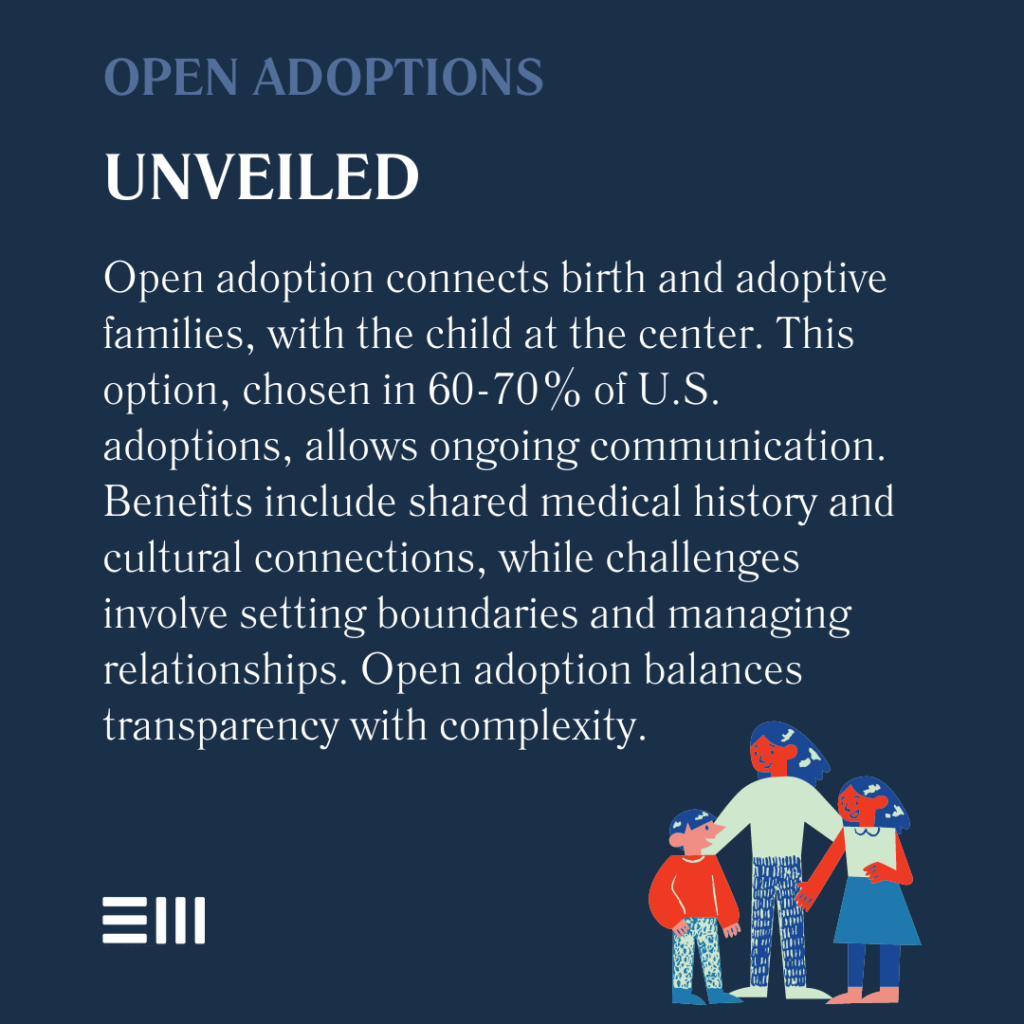
Imagine holding a photograph of your child’s birth parents in your hands. For some adoptive families, this is a treasured keepsake.
For others, it’s an unthinkable scenario. Which feels right to you? This pivotal question lies at the heart of one of the most significant decisions in the adoption process: choosing between an open or closed adoption.
In Alabama, where over 700 children find forever homes through adoption each year, this choice shapes not just your family’s future but also the life journey of the child you welcome into your heart.
Understanding Open Adoptions
Open adoptions have gained popularity in recent years, accounting for approximately 90% of domestic adoptions in the United States.
This type of adoption allows for varying degrees of contact between birth parents, adoptive parents, and the adopted child.
What Is an Open Adoption?
In an open adoption, identifying information is shared between birth and adoptive families. This can include names, addresses, and ongoing communication throughout the child’s life.
The level of openness can vary widely, from occasional updates to regular visits.
Benefits of Open Adoptions
Open adoptions offer several advantages:
- Access to medical history: Adoptive parents can easily obtain updated medical information, crucial for the child’s health.
- Identity formation: Adopted children can better understand their background and heritage.
- Reduced feelings of abandonment: Children may experience less confusion about their adoption story.
- Birth parent peace of mind: Birth parents can witness their child’s growth and development.
These benefits highlight how open adoptions can foster a sense of connection and transparency for all parties involved, potentially leading to more positive outcomes for the adopted child.
Challenges of Open Adoptions
While open adoptions have many benefits, they also present some challenges:
- Boundary setting: Establishing and maintaining appropriate boundaries can be difficult.
- Emotional complexity: Navigating relationships between birth and adoptive families may be emotionally challenging.
- Potential for disappointment: Expectations for contact may not always be met, leading to frustration.
Despite these challenges, many families find that the benefits of open adoption outweigh the difficulties, and with proper support and communication, these obstacles can often be successfully navigated.
How Open Adoptions Work in Alabama
In Alabama, open adoption agreements are not legally enforceable. However, many families choose to create informal agreements that outline the terms of ongoing contact. It’s essential to work with an experienced adoption attorney to navigate these arrangements effectively.
As we’ve seen, open adoptions offer unique opportunities for connection and transparency, but they also require careful consideration and planning.

Understanding Closed Adoptions
Closed adoptions, once the norm in the United States, have become less common in recent decades.
However, they remain an option for families seeking complete privacy and separation between birth and adoptive families.
What Is a Closed Adoption?
In a closed adoption, no identifying information is shared between birth and adoptive families. All records are sealed, and the parties typically have no contact after the adoption is finalized.
Benefits of Closed Adoptions
Closed adoptions offer certain advantages:
- Privacy: Both birth and adoptive families maintain complete confidentiality.
- Clear boundaries: There’s no ambiguity about roles or relationships.
- Emotional closure: Some birth parents find it easier to move forward without ongoing contact.
- Simplified family dynamics: Adoptive parents may feel more secure in their role as the child’s only parents.
These benefits demonstrate why some families still opt for closed adoptions, valuing the clarity and separation this arrangement provides in building their new family unit.
Challenges of Closed Adoptions
Closed adoptions also come with potential drawbacks:
- Limited medical information: Adoptive families may lack access to updated medical histories.
- Identity issues: Adopted children may struggle with questions about their origins.
- Difficulty with reunions: If a reunion is desired later in life, it can be challenging to locate birth family members.
While these challenges are significant, some families find that the benefits of a closed adoption align more closely with their needs and values, making it the right choice for their situation.
How Closed Adoptions Work in Alabama
In Alabama, closed adoptions are legally recognized and protected. Birth records are sealed upon finalization of the adoption, and access to these records is restricted.
However, Alabama does have a mutual consent registry that allows adopted individuals and birth parents to reconnect if both parties agree.
As we can see, closed adoptions provide a different set of benefits and challenges compared to open adoptions, catering to those who prioritize privacy and clear separation.

Comparing Open and Closed Adoptions
When deciding between open and closed adoptions, consider the following factors:
Communication and Contact
- Open Adoption: Allows for ongoing communication and potential in-person contact.
- Closed Adoption: No direct communication or contact after the adoption is finalized.
Access to Information
- Open Adoption: Provides access to medical history and family background information.
- Closed Adoption: Limited access to information beyond what’s provided at the time of adoption.
Emotional Impact on the Child
- Open Adoption: May provide a sense of continuity and understanding of personal history.
- Closed Adoption: May lead to questions about identity and origins.
Privacy Considerations
- Open Adoption: Requires balancing openness with privacy concerns.
- Closed Adoption: Offers complete privacy for all parties involved.
Legal Aspects
- Open Adoption: May involve informal agreements about contact and communication.
- Closed Adoption: Typically involves sealing of records and legal separation of birth and adoptive families.
By comparing these key aspects, you can better understand which type of adoption aligns more closely with your family’s needs and values.
Making the Right Choice for Your Family
Choosing between open and closed adoption is a deeply personal decision. Consider these steps to help you make the best choice:
- Reflect on your comfort level with ongoing contact.
- Consider the long-term impact on the child.
- Discuss your preferences with your partner and adoption professional.
- Learn from other adoptive families’ experiences.
- Be open to adjusting your expectations as circumstances change.
By carefully considering these factors and seeking professional guidance, you’ll be well-equipped to make a decision that serves the best interests of your family and the child you’re welcoming into your life.
Frequently Asked Questions About Open & Closed Adoptions in Alabama
As you navigate the complex world of adoption, you likely have many questions. Here, we address some of the most common queries about open and closed adoptions in Alabama.
Can an Open Adoption Be Closed Later?
While it’s possible to reduce or cease contact in an open adoption, it’s important to consider the emotional impact on all parties, especially the child. Any changes should be handled sensitively and with professional guidance.
How Does Alabama Law Address Open Adoptions?
Alabama law does not legally enforce open adoption agreements. However, many families choose to create informal arrangements that can be honored based on mutual trust and understanding.
What if Birth Parents Want More Contact in a Closed Adoption?
In a closed adoption, birth parents do not have the right to demand contact. However, if both parties agree, it’s possible to open communication channels through Alabama’s mutual consent registry.
How Do Adoptees Access Their Original Birth Certificates in Alabama?
In Alabama, adopted individuals can access their original birth certificates only through a court order or if both birth parents have consented through the state’s mutual consent registry.
What Support Is Available for Families in Open Adoptions?
Many adoption agencies in Alabama offer post-adoption support services, including counseling and mediation, to help families navigate the complexities of open adoption relationships.
These answers provide a starting point, but remember that each adoption situation is unique. Don’t hesitate to seek personalized advice from adoption professionals for your specific circumstances.
Take the Next Step in Your Adoption Journey
You’ve now gained valuable insights into open and closed adoptions. The next step is to apply this knowledge to your unique situation and confidently move forward.
Are you ready to explore your adoption options further? At Baxley Maniscalco, we’re committed to guiding you through every step of the adoption process in Alabama.
Our experienced team can help you navigate the complexities of open and closed adoptions, ensuring you make the best choice for your family’s future.
Contact us today for a confidential consultation. Let’s work together to create the family you’ve always dreamed of.
Can't find what you're looking for? Search our site below.










